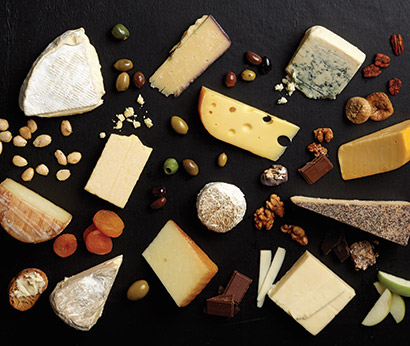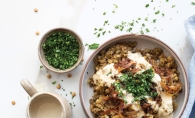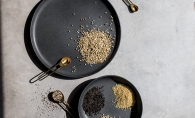’Tis the season, alright: the season of entertaining. To many, this can be a daunting proposition: The money, the time, the planning, the creativity required to make that memorable event can detract from the ultimate joy of getting together with loved ones. So this month we went to two local wine gurus in hopes of simplifying—and hopefully, relieving—some of those pesky mental stumbling blocks. Whether it’s a sit-down, multi-course wine dinner or a true wine-tasting party, we’ve got picks, pairings and tips from the pros for multiple price-points. So sit back, sip a glass of your favorite wine, and soak in these ideas for your next soiree.
Event 1: Wine-centric
Budget: $500–$600
People: 12–14
Wines: 18–20 bottles; picks courtesy of John Farrell, III, vice-president of sales for Haskell’s, 4130 Berkshire Lane N.
Menu: Appetizers
Most foods courtesy of Trader Joe’s, 11220 Wayzata Blvd., Minnetonka; 952.417.9080.
* Nuts, sweet and savory options: rosemary marcona almonds, sweet and spicy pecans, and candied walnuts
* Dried apricots
* Turkish figs
* Olives
* Cheeses (see pairings with wines)
* Crackers/French baguette
* Granny Smith apples
* Dark chocolate nutty bites
* Milk chocolate toffee
* Dark and milk chocolates
Six Wines:
- A sparkling wine, because bubbles are fun! The Louis Bouillot Cremant de Bourgogne Rose (around $15) is one of the better sparkles, a pinot noir with a touch of Gamay grape in the finish that has a pleasant rosey hue. Pair with camembert, $6.99/lb.
- Silver Bleach Sauvignon Blanc (around $10), a New Zealand sauvignon blanc from the Marlborough region, has all the zest, citrus and flavor without any sweetness in the finish. It’s light and crisp and great for food. Pair with Delice de Bourgogne—a triple crème soft-ripened cheese from France $11.99/lb.
- Sometimes Chardonnay is the wine to have; however, a buttery, oaky wine can be too much. Terraces Chardonnay 2010 (around $25) has great fruit flavors and a nice balance without a ton of oak. It might be, in my opinion, one of the better chards from California. Pair with manchego $9.99/lb.
- Cotes du Rhone are blends of syrah and Grenache; they are a perfect match with food. Chateau Cabrieres Cotes du Rhone (around $15) pairs excellently with food from the barbecue or spicy chicken, yet can be fruity and light enough to have its own, too. These have been known to be the perfect wines to have by the fire. Pair with Madrigal cheese, $6.49/lb.
- Chateau Mille Anges 2009 (around $14) Bordeauxs are a blend of cabernet sauvignon and merlot that sometimes have a third or fourth grape in the mix as well (a malbec or cabernet franc, for example). This one will open up with more air (consider a decanter), and soften and soften with time. It’s a great wine to have with food and finish the meal. Pair with cave-aged bleu cheese OR
- A French wine made in the American or Californian style, La Forge Cabernet Sauvignon 2011 (around $11) is more fruit forward. 2011 is still a bit young, and this wine will age well. It makes for a great match with bigger foods like ribs. Pair with Toscano cheese with black pepper

Event 2: Food-heavy
Budget: $300–$400
Guests: 8–10 (as many as fit around your table)
Wines: 10–12 bottles; picks courtesy of Christian Nesheim, Vinifera, 1400 County Road 101.
Menu: Sit-down
* Trader Joe’s classic cracker assortment
* Deviled eggs
* Olives
* Cheese Ball
* TJ’s bruschetta on a toasted baguette
* Chopped winter salad
* Peppered smoked salmon and cream cheese with chives on a toasted baguette
* Thanksgiving meatballs (see plymouthmag.com for the editor’s own recipe!)
* Chocolate brownie trifle
Five Wines
- A sparkling wine, like a prosecco, not too sweet (moscattos, while wildly popular now, are very sweet) and not too dry (the most famous bubbly, French Champagne, can be quite dry). Pair with mini basque cheese, $10.99/lb.
- White, something unique to go with appetizers and/or salad course. Nesheim likes a Gruner Veltliner, an Austrian wine that’s a bit drier and pairs really well with vegetables—even asparagus. Pair with Vintage Reserve cheddar $4.29.
- If white, chardonnay, the oakiness of which is totally up to the host(ess). If red, something lighter, like a pinot noir. This is the first wine of the main course or heavier apps. Pair with a chevre three-pack $4.99.
- Red, a nice Italian blend (for example, if serving Italian-influenced food), sometimes called a “super Tuscan,” a wine produced in nontraditional style for the Tuscany region (think cabernet-heavy, with some Bordeaux and some sangiovese). Pair with a creamy Toscano cheese soaked in syrah $7.99/lb.
- Dessert wine—there are both sweet and dry varieties of these, too. Port is great and dry, excellent to pair with chocolates. Sweet whites, like an ice wine (made from grapes that are frozen either naturally or after-harvest that are pressed while frozen, producing very little juice that has a high concentration of sugar), are good with lighter, fruitier desserts like crème brulee and tortes. Pair with a double-crème gouda $7.99/lb.
Tips from the Pros
From Christian Nesheim:
- First thing to do is to come up with your menu.
- From there, find your wine expert or app online—I recommend getting someone “live”, as what you can get in-store is going to be a lot more exotic than “pair red meat with cabernet.”
- Invite as many people as you can fit around your dinner table comfortably.
- Start out with something that sparkles. One thing that’s often overlooked in a wine party is the sparkling wine. It cleanses the palate and starts of a celebration on a fun note. Hand guests a glass as they walk in the door.
- You don’t need a food to pair with that first drink; just have something on the coffee table.
- Fast cool: Salt in an ice water bath will instantly chill.
- Reds should be served just BELOW room temperature, but NOT chilled. Put in the fridge for no more than 5 minutes right before serving.
- Food is for simultaneously cleansing a palate and balancing the flavors of the wine, and vice versa.
- Pick someone at that party to host the next one—host them every few months to catch the different seasons and different seasonal wines
- What if a guest doesn’t want to drink wine? You’re having a WINE party. Keep it simple, but make it fun.
- How much wine? Four to five glasses/bottle, so eight-10 bottles? Pour lightly so everyone gets the full experience; some people can have two of each kind, but not necessary.
From John Farrell III:
- Two rules when hosting a wine party: 1. Drink what you like. 2. Try new things.
- First figure out how much you want to spend, and the number of people you want to invite
- Remember that food is typically 1/3 to 2/3 of bill, more if you’re having the event catered
- Food is easy to simplify; no one needs to be in the kitchen: Do buffets, small apps, lay everything out, just enjoying the event is always the easiest way.
- Wine is an antiseptic. Don’t use water to rinse out wine glasses; splash a little of the new wine in, mix it around, dump, and then pour. This avoids additive flavors from flourides and other chemicals in city water
- The holidays are all about impromptu parties: Always have a couple of bottles chilled and ready to go.
- Rule of thumb: One drink per guest per hour, and have plenty of nonalcoholic options available—sparkling waters, fruit juices, bottled soda.
- Just about every store in town has a return policy where they’ll take back unopened alcohol—but unopened is completely untampered with, so don’t jump the gun.
- Never cook with a wine you wouldn’t drink.
- Entertaining shouldn’t be hard—it shouldn’t be something you’re afraid of. Go to stores where you trust your experts, then let them do the work if the budget allows.
Prep/Décor
- Glassware? Both Nesheim and Farrell suggest wine glasses, and they can be reused, but a good bet is having at least three—a champagne flute for the sparkling, a white glass and a red glass.
- Paper for notes? Not unless doing a true wine-tasting—this doesn’t work for sit-down or socially focused events. No one but sommeliers focus on the notes of appearance, smell, taste, feel, finish
- Theme your Event
- Blind tastings
- Tastings based on regions, “But keep it simple,” John Farrell says. “For example, Sicily would be too small/specific, Italy too diverse/broad.”
- Tastings based on grapes
- Follow the cheese wheel
- For the holidays, have a picnic in your living room in front of the fire place
- Each couple brings 2 bottles they’ve never tried

The Recipes
Thanksgiving Meatballs
Courtesy of Laura Haraldson
Yield: 12–18, depending on size of meatball
1 egg
1 lb. package lean ground turkey
2 Tbsp. water
3 oz. dried cranberries (or to taste)
1/3 cup chopped walnuts
½ tsp. seasoning salt
1/8 tsp. pepper (optional)
Maple syrup (optional)
Fresh parsley sprigs (optional)
Preheat oven to 350 degrees. In large bowl, combine egg, water, chopped walnuts, dried cranberries, seasoning salt and pepper, and combine. Add ground turkey, and mush with your hands to combine. Form into meatballs about one-inch in diameter, and place on a broiler pan. Bake at 350 degrees for 25 to 30 minutes until meatballs are no longer pink in center. Serve immediately, with maple syrup drizzled on top, or cool and freeze. Garnish with fresh parsley.
Brownie Toffee Trifle
Courtesy of Jacqueline Hagyard
1 package of brownie mix
1 package of chocolate pudding
1 package of vanilla pudding
1 package of whipped topping
1 package of toffee bits
1 package of heath bits
1. Bake brownies according to package directions. Cool. In 3 separate bowls prepare pudding and whipped topping according to package directions; set aside.
2. Cut brownies into small 1 1/2 inch cubes, place 1/2 the cubes in the bottom of a 4 1/2 or 5 qt. trifle dish or decorative glass bowl.
3. Layer with 1/2 the chocolate pudding, top with 1/2 pkg of toffee bits, then layer with 1/2 the vanilla pudding. Repeat the layers of the brownies, chocolate pudding toffee bits and then vanilla pudding.
4. Top with the whipped topping and sprinkle with heath bits. Refrigerate 4-5 hours before serving. Yield: 8-10 servings.
Winter Salad
Inspired by a recipe found in Real Simple, revised by Rae Danneman
1 small butternut squash (about 1 1/2 pounds)—peeled, seeded and cut into 3/4-inch pieces
3 Tbsp. olive oil
Kosher salt and black pepper
1/4 cup red wine vinegar
2 Tbsp. chopped fresh dill
1 small head radicchio, leaves torn (6 cups)
1 15.5-oz. can chickpeas, rinsed [optional]
4 oz. Feta, crumbled (about 1 cup)
1 tart apple (such as Granny Smith or Pink Lady), sliced
1/4 cup pitted kalamata olives, halved [optional]
Roast squash with olive oil, salt and pepper, to taste, at 450° F for about 30 minutes. Let cool slightly. In a large bowl, whisk together the vinegar, dill 2 Tbsp. oil and ¼ tsp. each salt and pepper. Add the squash, radicchio, chickpeas, Feta, apple and olives, and toss to combine.
Rae's Cheese Ball
2 8 oz. packages cream cheese, softened
1 C. grated cheddar cheese
1/2 C bleu cheese crumbles
dash worcestershire sauce
1 T minced onion
1/2 tsp. paprika
1 C chopped pecans
1/4 C + 1 T chopped parsley
In a food processor, blend the cheeses. Then add the dash of Worcestershire sauce, onion, paprika, and 1 T parsley, process until just mixed. Form into a ball and roll in the chopped nuts and remaining chopped parsley. Rolling on waxed paper or a large plate works well. Cover tightly and chill. Serve with crackers and slices of bread.









